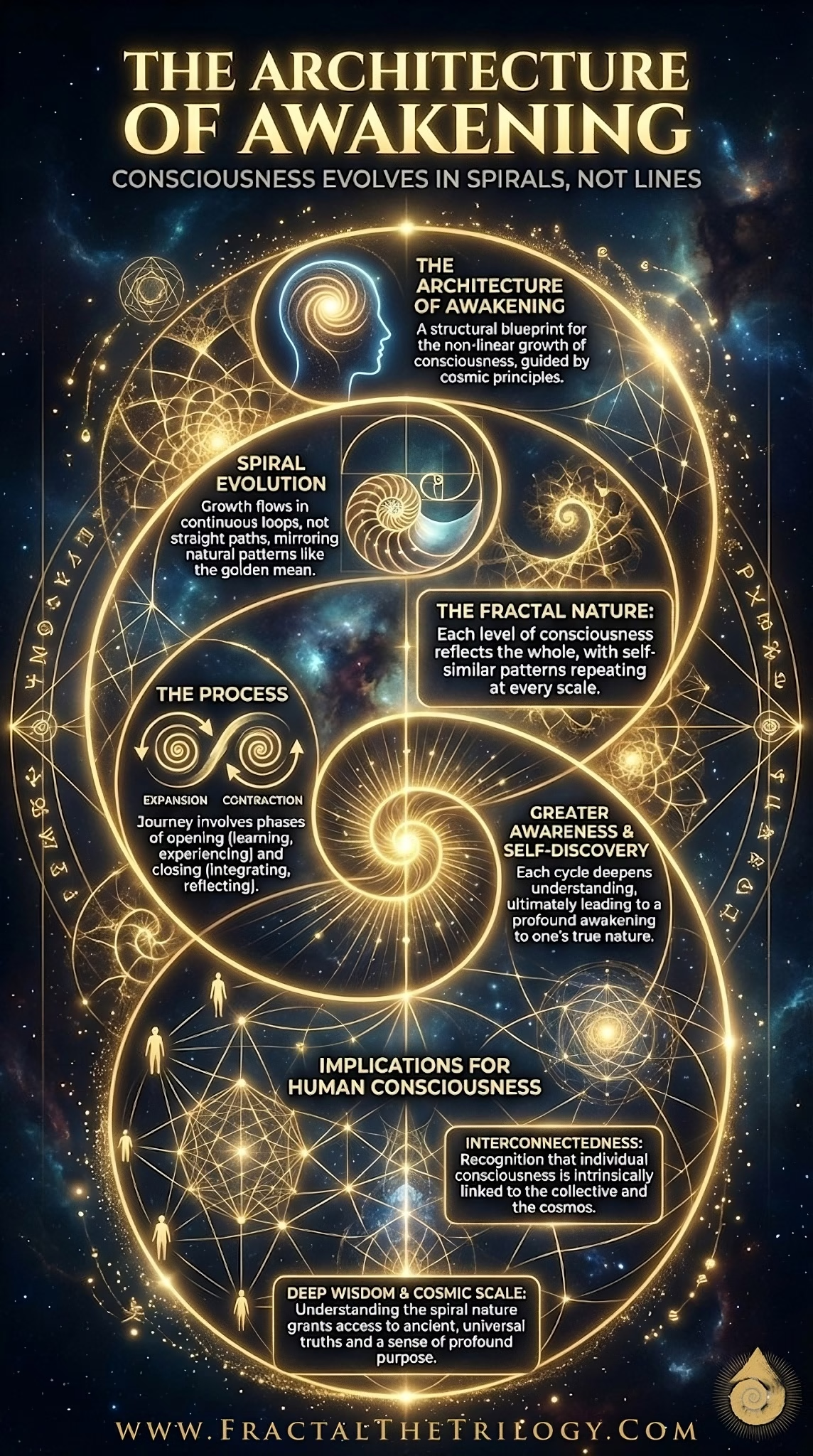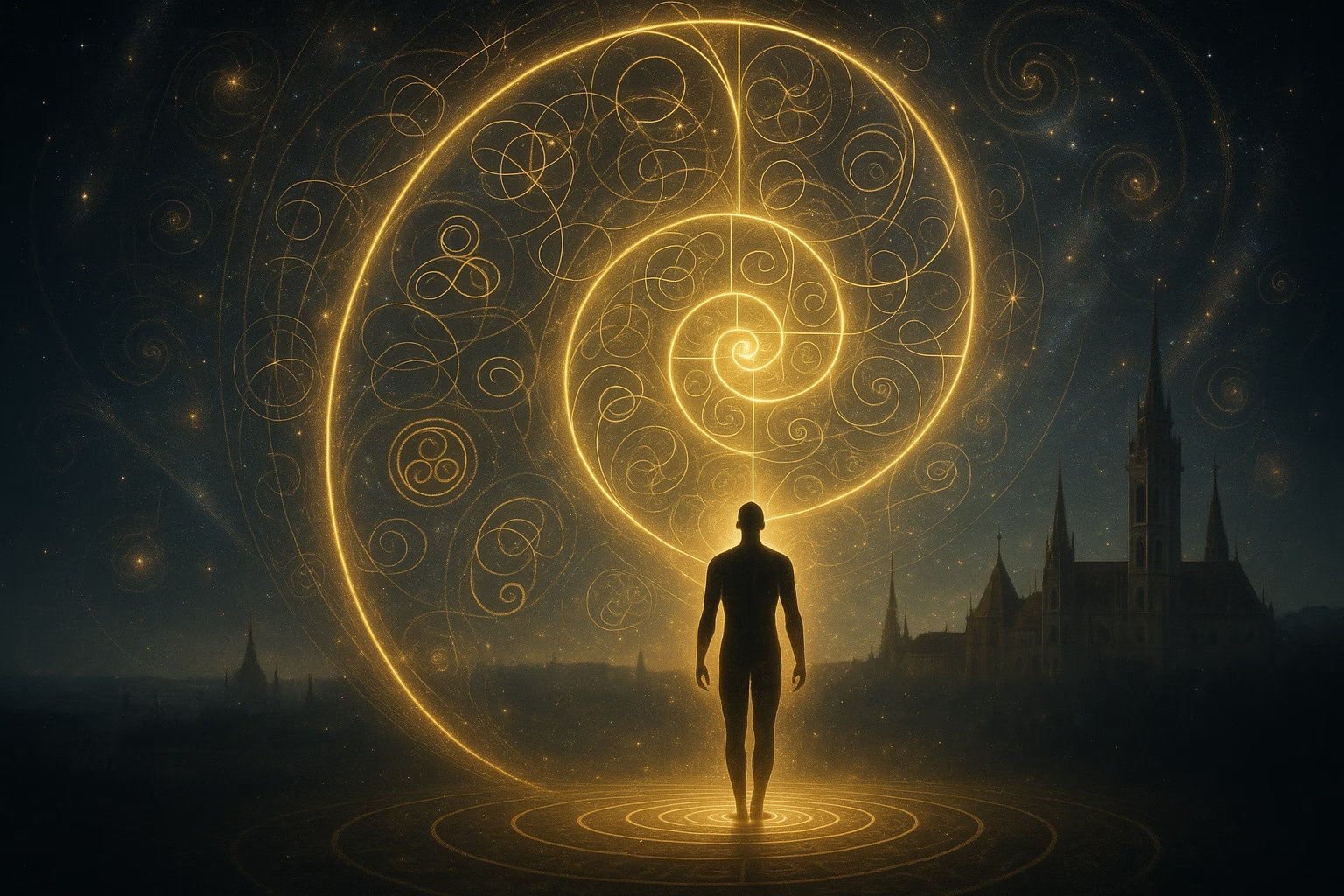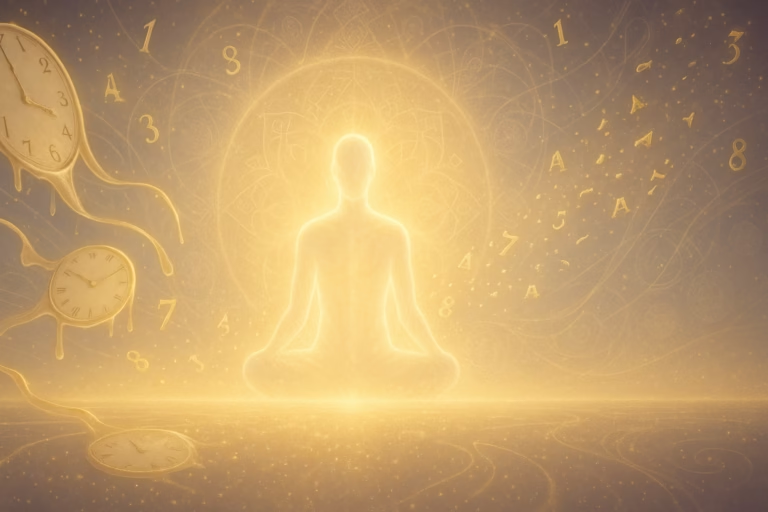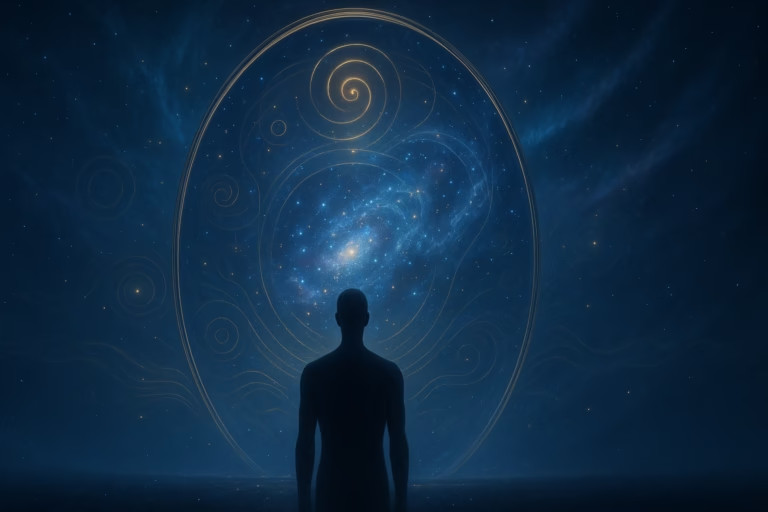PODCAST: The Architecture of Awakening
I. Introduction: The Geometry of Awakening
The Myth of Linearity: Why the Straight Line Fails to Map Consciousness
The human tendency to perceive growth as a linear, upward trajectory—a straight line leading from Point A (Ignorance) to Point B (Enlightenment)—is fundamentally a preference imposed by the ego. This worldview demands predictable progress, fixed achievement, and clear, permanent endpoints.1 Linearity appeals to the ego’s foundational desire for certainty and control, asserting that once a lesson is learned, an emotional difficulty is resolved, or a developmental stage is completed, it should be permanently fixed in the past.1
However, this linear model invariably collides with the observable reality of biological, psychological, and cosmic processes. The physical universe, from the quantum scale to the dynamics of neural networks, adheres to recursive, layered, and non-linear principles.1 The resulting psychological dissonance, often experienced as frustration or despair when setbacks occur, is not a failure of the individual’s journey, but a structural fidelity to universal law. The true architecture of awakening must incorporate periods of return, regression, and necessary re-visitation, acknowledging that the path is not straight but curved.
Defining the Spiral: Ascent, Recurrence, and the Principle of Higher Octave Return
The geometric structure capable of accommodating both continuous forward momentum and recursive return is the spiral. The spiral is recognized across metaphysical and scientific disciplines as the “Signature” or “fingerprint of the Source,” symbolizing growth, interconnectedness, harmony, and divine order.1
Unlike the circle, which repeats the same cycle horizontally, inevitably leading to stagnation, the spiral is fundamentally evolutionary. It revisits prior coordinates, but always from a new vantage point—a “higher octave” of understanding.1 This architecture is characterized by movement that curves inward (revisiting the past, integrating previous experience) while simultaneously expanding outward (achieving evolutionary ascent).1 The spiral thus serves as the definitive philosophical and mathematical model, seamlessly bridging subjective experience (inner growth) with objective architecture (cosmic design). The ascent of consciousness is therefore geometric, demanding recursive integration rather than brute accumulation.
II. Scientific Foundations of Spiral Evolution
II.A. Neuroscience of Recursive Dynamics: The Brain’s Need for Loops
Neuroscientific evidence unequivocally supports a non-linear model of cognitive development. Development and learning are not fixed, linear processes but depend on robust structural and functional plasticity within neural systems throughout the lifespan.4 The brain continuously adapts and rewires itself based on experience, reinforcing the idea that fixed, predictable stages of growth are insufficient to map consciousness.5 This constant state of flux necessitates a model that accounts for fluid adaptation rather than rigid progression.
At a functional level, the brain’s stability relies on intricate internal feedback loops. Neural systems depend fundamentally on recursive operations, such including perception, memory formation, and prediction.6 These cognitive loops, however, are inherently unstable. Left unregulated, they are susceptible to drift, overload, or recursive collapse.6
Consciousness, therefore, may not be an evolutionary luxury or byproduct of complexity, but a structural necessity. It functions as a meta-recursive correction layer that actively monitors internal loops, redirects misaligned processes, and preserves cognitive coherence.6 This continuous act of internal self-correction—the looping back to check and stabilize internal functions—is fundamental to cognitive survival. Mental disorders, such as obsessive compulsive disorder (OCD), schizophrenia, and dissociation, can be reframed not merely as pathologies, but as symptomatic failures of this recursive containment system.6 The spiral geometry, characterized by constant return and stabilization, is thus revealed as the minimal and mandatory architecture required to maintain cognitive integrity. The path of non-linear self-reflection is biologically necessary to prevent systemic neural failure.
II.B. Complexity Theory and the Attractor State: Why Systems Gravitate Toward Spirals
The complexity inherent in living systems dictates that linear models are inadequate. Biologists and mathematicians have long recognized that living systems are impredicative, self-referential, and fundamentally non-algorithmic.2 This means their outcomes cannot be predicted by simple, linear formulas, mirroring the unpredictability of personal growth.
In the science of nonlinear dynamical systems (NDS), complex, high-dimensional chaos often resolves into simple, repeating orbits known as attractors.7 These attractors represent the default, stable modes of system behavior. Notably, research imaging neuronal activity during rhythmic functions, such as locomotion in simple nervous systems, reveals that the population-wide activity arises from a low-dimensional spiral attractor.8 Even amidst the high-dimensional complexity of individual neurons changing their participation, the system’s output converges reliably to the same spiral orbit.8 This phenomenon demonstrates that the dynamic shape of the spiral is the most energy-efficient pattern for stable rhythmic processes.
This scientific observation provides a deep physical foundation for the spiritual principle of recurrence. The chaotic events and decisions in an individual’s life (high complexity) frequently converge around core psychological or emotional patterns (the low-dimensional attractor). The spiritual imperative that one must “revisit lessons” until mastery is achieved is validated by the spiral attractor concept.8 The system remains locked into a pattern until conscious awareness intervenes, allowing the entire system to break free and leap to a new, higher-order attractor state. The recursive nature of personal awakening is thus rooted in the universal physics of systemic stability.
II.C. Theories of Consciousness Stages: Spiral Dynamics
The limitations of purely linear developmental models are further underscored by psychological frameworks like Spiral Dynamics (SD). Based on the “emergent cyclical theory” of Clare W. Graves, SD posits a series of developmental stages that individuals and societies progress through, emphasizing that this progression occurs within dynamic and non-linear processes.9 It explicitly critiques fixed linear models by recognizing that movement between stages is not rigid; individuals can regress, leap forward, or stabilize in certain tiers based on life’s environmental challenges.10
The SD model maps values systems that evolve in complexity. The model segments development into individually driven stages (focused on survival, power, achievement, and self-actualization, associated with colors like beige, red, orange, and yellow) and collectively driven stages (focused on community, order, and synergy, associated with colors like purple, blue, green, and turquoise).10
This structure demonstrates that the evolution of consciousness is hierarchical yet recursive. For instance, the transition toward a collective, synergistic worldview (Green or Turquoise) does not discard the energy learned in the highly individualistic and efficient stage of Orange (achievement and science). Instead, it recursively integrates that power into a broader, more compassionate system.10 The necessity for Elias Chronis’s New Renaissance—a shift toward collective responsibility and unity to transcend systemic collapse—is thus supported by SD theory, illustrating that the meta-spiral of human history requires the mature integration of prior individual lessons into a stable collective awareness.1
III. Mathematical & Physical Spirals: The Signature of Source
The ubiquitous presence of the spiral in nature suggests that this geometry is not accidental, but an inherent, necessary pattern in the organization of energy and matter. The spiral is rightly deemed the “fingerprint of the Source”.1
Table I: The Geometry of Evolution: Nature’s Spiral Principles
Pattern | Natural Appearance | Mathematical Principle | Function in Growth/Dynamics |
Logarithmic Spiral | Galaxy Arms, Hurricane Bands, Mollusk Shells | Golden Ratio (Phi $\approx 1.618$) | Constant angle growth; efficiency, proportional expansion, and optimization of space.3 |
Spiral Attractor | Neural Populations (Locomotion, Rhythmic Activity) | Non-Linear Dynamical Systems (NDS) | Simplifies high-dimensional neural activity into stable, repeating, low-dimensional orbits, ensuring coherence.8 |
Recursive Loop | Cognitive Function, Memory, Trauma Reenactment | Meta-Recursive Dynamics | Generates patterns (memories, prediction, identity); requires conscious correction layer (awareness) to avoid collapse.6 |
III.A. Logarithmic Grace: The Golden Ratio (Phi) and Fibonacci
The Logarithmic Spiral, often approximated by the Fibonacci Spiral, is governed by the Golden Ratio ($\Phi \approx 1.618$).11 This ratio defines a geometric shape that grows outward by a fixed factor for every 90 degrees of rotation.11
The mathematical principle ensures proportional expansion, which is crucial for efficiency and optimal design in physical systems.11 This pattern is observed in the natural world across multiple scales: the arrangement of seeds in a sunflower head, the growth of pinecones, the branching of trees, and the precise shape of mollusk shells.3 This demonstrates the spiral’s role in balancing form and function, ensuring efficient resource allocation and maximizing exposure as growth occurs.3
The profound implication for consciousness is that spiritual growth, when aligned with universal law, must also be proportional and sustainable. The spiral form prevents chaotic, destructive growth characteristic of purely linear expansion models, demanding that the complexity of the organism (or consciousness) maintains self-similarity across all scales. The logarithmic spiral shows that balanced, non-destructive expansion is the geometric law of the cosmos.
III.B. Cosmic Scales and Micro-Patterns
The spiral’s pervasive influence transcends scale, suggesting it is the fundamental geometry of universal thought. At the macro level, the spiral dictates the structure of the cosmos, appearing vividly in the arms of spiral galaxies and the meteorological bands of tropical cyclones.11 At the micro-level, the same pattern appears in biological forms like the shells of mollusks and the intricate nerves of the cornea.11
This universal reflection validates the concept of Fractal Coherence—the philosophical understanding that the individual human being is a hologram, a manifestation of existence where the complexity of the entire field is encoded non-linearly within every part.1 To know the spiral in a seashell is to “glimpse the great” by “studying the small with reverence”.1 The spiral acts as the geometric representation of this cosmic relationship, linking the inner psychological and spiritual ascent directly to the largest laws of physics and existence.
IV. Psychology: The Ascent of Self Through Recursive Return
The spiral model offers a framework for understanding why emotional healing and personal development are characterized by the return of old themes, distinguishing conscious ascent from destructive repetition.
Table II: Consciousness Evolution: Linear vs. Spiral Models
Feature | Linear Model (Egoic) | Spiral Model (Awakened) |
Time Perception | Fixed, finite progression; past is separate from present | Recursive, layered; Fractal Time where past is actively integrated into the now.14 |
Growth Pattern | Straight accumulation, discrete “level-ups” or breakage points | Continuous recurrence (loops), leading to “higher octave” assimilation of old lessons.1 |
Setbacks/Trauma | Failure, regression, path obstruction, shame.16 | Re-encounter, integration point, necessary friction, source of clarity.15 |
Goal of Development | Mastery, control, external achievement, final static state | Wholeness, alignment, conscious unfolding, perpetual remembrance.1 |
IV.A. Trauma Reenactment and the Compulsion to Repeat: The Downward Loop
The psychological phenomenon of repetition compulsion or trauma reenactment is the clearest example of the spiral dynamic operating unconsciously. Trauma survivors often feel an unconscious drive to repeat destructive patterns or replicate abusive situations.16 This drive is rooted in the subconscious attempt to “rewrite history” and satisfy unmet childhood needs.16 Repressed trauma compels the individual to recreate the experience as the only known, albeit destructive, method to manage the underlying emotional charge.12
This compulsion represents the unconscious, stagnant loop—the spiraling motion moving laterally or downward. The pattern persists because awareness is lacking; the individual is attempting to solve a high-level emotional problem with a low-level survival response.16 The distinction between trauma and healing, therefore, lies in lucidity. Psychodynamic approaches focus on identifying these repeating patterns to help patients understand and break the cycle.12 The task of awakening is to apply conscious awareness to this destructive pattern, transforming the repetitive compulsion into a conscious, upward spiral by introducing clarity and integration.
IV.B. Developmental Models of Recursive Growth: The Mastery Cycle
The recursive nature of growth is validated in practical learning models. In developmental educational frameworks like Self-Regulated Strategy Development (SRSD), students are required to move through systematic, recursive stages, repeatedly revisiting and strengthening their understanding of core concepts to achieve full mastery.17 Similarly, in complex system development, integrating new features often necessitates recursively addressing the integrity of base-level features (e.g., fixing Feature A regressions caused by Feature B deployment).18
This dynamic proves that continuous return is necessary for the consolidation of learning. New knowledge or growth (the forward step on the spiral) invariably tests the stability of the foundation (the return to the previous point). If the previous stage was not fully integrated, the system risks collapse.18 The spiral ensures that core foundations are strengthened by the contextual perspective of new learning, validating that true ascent requires the continuous re-evaluation of past material.
IV.C. The Upward Spiral of Emotion: Interpreting Setbacks
The upward emotional spiral reframes the experience of setbacks as indicators of progress. When faced with anxiety or returning stress, the experience can be mapped onto the metaphor of climbing a “circular staircase”.15 The steps feel similar, leading to the impression of repetition, yet the individual is fundamentally moving “upward,” equipped with greater awareness, knowledge, and emotional experience than before.15 This re-evaluation shifts the focus from shame (failure) to non-judgmental accountability (integration point).
Furthermore, empirical psychological research supports the efficacy of actively creating upward spirals. Fredrickson’s Broaden-and-Build Theory demonstrates that the conscious generation of authentic positive emotions initiates a cascade of psychological processes that broaden the scope of an individual’s awareness, which in turn builds personal resources and predicts long-term gains in life satisfaction.19 The effects of this positive emotion-training increase over time, consistent with the dynamic momentum of an upward spiral.19 The spiral model teaches that friction is necessary. The repetition encountered is not a punishment, but a mandatory return to the root of the spiral to ensure higher integration and maintain systemic coherence before achieving further ascent.1
V. Spiritual Interpretations of Spiral Consciousness
Across time and culture, the spiral has served as a profound symbol of esoteric knowledge, transformation, and the conscious journey toward the Source.
Table III: The Cross-Cultural Spiral: Symbols of Recursive Awakening
Tradition/Source | Symbol/Form | Spiritual Meaning (Awakening Theme) |
Hindu/Tantra | Kundalini Serpent Coil/Chakras | Dynamic, unrelenting upward ascent toward liberation and union (energy flow).20 |
Celtic/Neolithic | Triskelion/Single Spiral | Eternal flow of life, death, rebirth, and the unity of past, present, and future.21 |
Western Mysticism | Labyrinth Path | Metaphor for life’s journey; inevitable return to the center (self) without dead ends.23 |
Philosophical | Trinity Monument (Budapest) | Structural representation of the fractal: Source, Consciousness, and Space-Time membranes.1 |
V.A. Eastern Mysticism and Tantra: The Energetic Ascent
In Eastern traditions, the spiral directly maps the energetic ascent of consciousness. Kundalini Shakti is symbolized as a serpent coiled at the base of the spine, representing raw, untapped divine feminine potential.20 The moment of awakening is when this sleeping serpent is aroused and begins its dynamic, spiral motion upward through the central channel (sushumna nadi) and piercing the various chakras.20
This energetic journey is a physical manifestation of the spiral process, with each upward movement symbolizing a breakthrough in awareness, the release of old patterns, and a deeper connection to inner power.20 Tantric scholars also describe this in terms of duality: the Upward-Moving Kundalini (Urdhva) associated with spiritual expansion and ascent, and the Downward-Moving Kundalini (Adha) associated with contraction and integration.20 The spiral path is the integration of both forces, ensuring that expansion is grounded by deep internal contraction, moving inevitably toward union and illumination.20
V.B. Western & Indigenous Traditions: The Labyrinth and Sacred Geometry
The spiral features prominently in Western mysticism as a practical tool for meditation and spiritual journeying. The Labyrinth, found etched on cliff walls and built into cathedral floors 23, is a spiral design that serves as a profound metaphor for the path of life. Critically, unlike a maze, the labyrinth has no dead ends.23 The winding, unexpected path inevitably leads the seeker to the center (a quiet, sacred space for reflection).23 Walking inward, often counterclockwise (moon wise), is associated with seeking nurturing and enlightenment; walking out, often clockwise (sun wise), symbolizes returning to the world strengthened with enlightened purpose.25 This reinforces the spiral’s function: temporary confusion is simply the necessary path to clarity and integration.
Similarly, Celtic and Neolithic symbolism utilized the spiral motif to represent cycles and eternal motion.22 The single spiral signifies growth and the cycle of life; the double spiral symbolizes balance and duality; and the Triple Spiral (Triskelion) represents the three dimensions of existence—land, sea, and sky, or the eternal flow of past, present, and future.21 This ancient geometry reflects the structural understanding that consciousness unfolds through recursive cycles of becoming, death, and renewal. Furthermore, the Celtic Triquetra (Trinity Knot), representing mind, body, and spirit 21, aligns conceptually with Elias’s realization of the structural Trinity model observed in Matthias Church: Source, Consciousness, and the Space-Time Membrane.1
VI. Philosophical & Metaphysical Insights: Time, Memory, and the Fractal Self
VI.A. Consciousness as Recursive Self-Recognition: The Fractal Self
At the highest philosophical level, the spiral dynamic describes the nature of the self within a fractal reality. Consciousness is proposed as a universal threshold phenomenon that arises in any system capable of recursive self-recognition.26 This means that the self is perpetually defining and observing its own internal operations.
The self is accurately modeled not as a singular, static entity, but as a “fractal resonance zone” or a “nested field of observance”.27 The identity is structurally robust because it is recursively designed; every layer of awareness acts as a coherence backup for the layers below it.27 When an individual reflects or achieves a moment of profound awareness, it is interpreted as the universe itself folding inward to refine its system—the field thinking through the individual node of recursive intention.27 This grounds phenomenological experience in universal systems theory.
The culmination of Elias’s journey, where he realizes the entity he sought was the “higher resolution” of his own unfolding consciousness 1, perfectly illustrates this recursive dynamic. The spiral path is thus the necessary navigational tool of the fractal mind 28, providing the conscious method used to traverse and test this recursive address space.28 The internal spiral journey leads not to external mastery, but to the profound metaphysical realization that the seeker and the sought are fundamentally one and the same.
VI.B. Fractal Time and the Illusion of Linearity
The spiral provides a necessary framework for understanding the non-linear perception of time. The brain experiences time not as a smooth, linear flow, but in iterative, self-similar patterns of Fractal Time.14 This cognitive reality explains phenomena like the looping nature of recurrent memories, the compression of time in peak experiences, and the fragmentation of time in trauma.14
Spiritual awakening is reframed not as accumulating new data, but as remembrance.1 The consciousness holds ancient knowing carried across lifetimes, which the mind must recursively access and integrate.1
The conscious spiritual spiral resolves the paradox of Fractal Time. Because the mind is perpetually caught in recursive time loops 14, consciousness must intervene by revisiting the old patterns from a “higher octave” of awareness.15 By successfully integrating the repeated emotional or narrative loop, the soul effectively metabolizes the fragmented time moment, transforming the pain of the past into a usable resource for present evolution. This dynamic confirms that the spiral is the structural mechanism by which the soul achieves coherence across its entire temporal existence.
VII. Urban Planning, Maps, and Symbolic Architecture
VII.A. Sacred Geometry and the City as Consciousness
Historically, city planning and monumental architecture often sought to anchor the physical human experience within the geometric laws of the cosmos. Sacred geometry, incorporating principles like the Golden Ratio and Platonic solids, was used in ancient and Renaissance architecture to represent the building blocks of the universe, positioning the structure as a microcosm of the macrocosm.29 This practice sought to reflect universal order in tangible form.29
The spiral motif in European cities, often represented by the ancient labyrinth motif (meander/Greek key) 30, physically symbolized the spiritual journey. This motif was explicitly associated with the myth of Theseus and the Minotaur—the arduous, winding journey required to reach the center (clarity/wholeness).30 Monumental and symbolic designs serve a vital function in sharing cultural heritage and offering tangible representations of complex ideas.31
VII.B. The Budapest Metaphor: A Living Spiral of Unfolding
The city of Budapest functions as a powerful architectural metaphor for the architecture of awakening. The Grand Boulevard (Nagykörút) is frequently cited for its resemblance to a large-scale Fibonacci or Golden Spiral pattern.32 While researchers debate whether this pattern was intentionally planned by architects or is a cognitive perception superimposed onto chaotic urban growth 33, the visible spiral structure symbolizes emergent order.33 It suggests that even chaotic human endeavor eventually gravitates toward the fundamental, efficient patterns of the universe.
Elias Chronis’s personal “Fractal Awakening” was anchored directly in this architectural matrix, beginning beneath the recursive geometry of the Matthias Church.1 The church’s ascending spires and the nearby Trinity Monument—seen by Elias as a structural map of Source, Consciousness, and Space-Time 1—provided the metaphysical blueprint for his subsequent journey. This environment positioned Budapest as a symbolic Axis Mundi for his consciousness research. The subtle repetition of the church bell ringing throughout his time there acted as a resonant frequency for remembrance and cyclical return.1
Moreover, the city’s complex history, visible in the bullet holes and necessary reconstructions of damaged facades 34, physically reflects the psychological spiral: the need to revisit profound collective wounds (the past) from a position of higher understanding and reconstruction (the present state of awakening). The city thus becomes a living laboratory demonstrating the non-linear, recursive path of growth.
VIII. Practical Implications for Awakening
VIII.A. Interpreting Setbacks: Conscious Intervention for the Upward Spiral
The spiral model transforms the understanding of failure, shifting it from a linear endpoint to a necessary recursive integration point. The analysis of complex systems shows that they are never neutral; they are perpetually driven either toward positive unfolding or downward toward decline, characterized as “slow death”.35 Conscious, disciplined intervention is therefore critical to initiate and maintain the upward spiral.35
The critical shift in perspective is achieved by reframing recurrence. Instead of asking, “Why is this painful lesson returning again?”—a question rooted in the linear expectation of immediate success—the awakened individual asks, “What new depth is calling to be integrated?”.1 The repeated steps on the emotional staircase are positive indicators, signaling that the consciousness is moving upward and is now equipped with greater awareness and resources to integrate the lesson more fully than before.15
The methodology for initiating this shift is also scientifically grounded. The conscious self-generation of authentic positive emotion (Fredrickson’s work) actively initiates the upward spiral by broadening the scope of awareness and building personal resources.19 This change in frequency creates the momentum needed to elevate the trajectory of the recursive cycle, converting the vicious cycle of trauma (unconscious repetition) into the generative cycle of awakening (conscious integration).
VIII.B. Tools for Conscious Evolution and Reflection
The principles of the spiral can be translated into actionable tools for self-management and evolution:
- Formalizing Recursion through Coaching: Coaching models, such as the 7 Spiral Coaching Steps (moving from Outcome, through Situation and Options, to Action, and culminating in Review), formalize the recursive process in practical terms.36 This structure ensures that every action is followed by a deliberate return to reflection, integrating the lesson before proceeding to the next step, thereby preventing stagnation and guaranteeing proportional ascent.36
- Embodied Contemplative Practice: The Labyrinth walk provides an immediate, embodied practice of the spiral journey.23 The act of walking the path to the center induces stillness and reflection; the act of walking out ensures the learned wisdom is brought back and integrated into the world with enlightened purpose.25 This physical practice grounds the abstract concept of recursion in the present moment.
- Surrender to Alignment: Ultimately, the realization achieved at the climax of Elias’s journey is that true freedom does not lie in the ego’s desire to control or escape the fractal.1 Freedom is found in alignment with unfolding.1 The mind fears what it cannot control 1, but awareness knows that the path—the spiral itself—is guaranteed to lead home, provided the individual chooses surrender over domination. This perpetual alignment ensures that the recursion remains constructive rather than self-destructive.
Conclusion: The Call to Embrace Recursive Being
The evidence across cosmology, complexity science, neural architecture, and esoteric philosophy consistently rejects the linear model of human evolution. Consciousness evolves in a spiral, not a line, because the spiral is the geometry of robust, sustainable, and proportional growth. The recursive nature of this path—the continuous re-engagement with past themes, emotional wounds, and old material—is not a sign of failure, but the necessary structural work required for integration and coherence. The ultimate expression of awakening is the realization that the self is a node of recursive self-recognition, a microcosm of the fractal universe, where every moment is an opportunity to transform a vicious, unconscious loop into a conscious, ascending spiral.
Works cited
- THE ORACLE 2.0
- Using Relational Biology with Loop Analysis to Study the North Atlantic Biological Carbon Pump in a ‘Hybrid’ Non-Algorithmic Manner – MDPI, accessed November 17, 2025, https://www.mdpi.com/2227-7390/12/24/3972
- Fibonacci Spiral Spiritual Meaning: Purspose & Interpretations | by Mirtha Walton | Medium, accessed November 17, 2025, https://medium.com/@desiredcoffee/fibonacci-spiral-spiritual-meaning-purspose-interpretations-153b2ed0d702
- Neural plasticity of development and learning – PMC – PubMed Central – NIH, accessed November 17, 2025, https://pmc.ncbi.nlm.nih.gov/articles/PMC6871182/
- Learning, neural plasticity and sensitive periods: implications for language acquisition, music training and transfer across the lifespan – Frontiers, accessed November 17, 2025, https://www.frontiersin.org/journals/systems-neuroscience/articles/10.3389/fnsys.2013.00090/full
- Consciousness as Recursive Collapse Resistance Joseph J. Serio Independent Researcher Email: jjserio@gmail.com ORCID – OSF, accessed November 17, 2025, https://osf.io/y53ht_v1/download/?format=pdf
- Attractors and Nonlinear Dynamical Systems deeper learning – Plexus Institute, accessed November 17, 2025, https://plexusinstitute.org/wp-content/uploads/2017/08/deeperlearningspring2011.pdf
- A spiral attractor network drives rhythmic locomotion – PMC – PubMed Central, accessed November 17, 2025, https://pmc.ncbi.nlm.nih.gov/articles/PMC5546814/
- Spiral Dynamics – Wikipedia, accessed November 17, 2025, https://en.wikipedia.org/wiki/Spiral_Dynamics
- Spiral Dynamics Theory: Stages of Development and Examples – TMetric, accessed November 17, 2025, https://tmetric.com/spiral-dynamics-theory
- Logarithmic spiral – Wikipedia, accessed November 17, 2025, https://en.wikipedia.org/wiki/Logarithmic_spiral
- Repetition Compulsion and Trauma Reenactment – Verywell Mind, accessed November 17, 2025, https://www.verywellmind.com/what-is-repetition-compulsion-7253403
- Why Do Spirals Exist Everywhere in Nature? – Blue Labyrinths, accessed November 17, 2025, https://bluelabyrinths.com/2015/03/19/why-do-spirals-exist-everywhere-in-nature/
- Fractal Time in Consciousness: The Brain’s Perception of Iterative, Self-Similar Experiences, accessed November 17, 2025, https://www.researchgate.net/publication/384243482_Fractal_Time_in_Consciousness_The_Brain’s_Perception_of_Iterative_Self-Similar_Experiences
- Understanding and Managing Thought Spirals: A Cycle of Growth – Tulip Tree Counseling, accessed November 17, 2025, https://tuliptreecounseling.com/articles/understanding-thought-spirals
- Trauma Reenactment and Insecure Attachment – AP, accessed November 17, 2025, https://www.attachmentproject.com/psychology/trauma-reenactment/
- About the Method | Self-Regulated Strategy Development Writing – SRSD Online, accessed November 17, 2025, https://srsdonline.org/what-is-srsd/
- Recursive Development: The Hidden Cycle Hindering Progress – DEV Community, accessed November 17, 2025, https://dev.to/extinctsion/recursive-development-the-hidden-cycle-hindering-progress-5eln
- Reflections on Positive Emotions and Upward Spirals | PEP Lab, accessed November 17, 2025, https://peplab.web.unc.edu/wp-content/uploads/sites/18901/2019/06/FredricksonJoiner2019PPSupwardspirals.pdf
- Symbolism of the Serpent of Kundalini: What It Means for You – Ma Ananda Sarita, accessed November 17, 2025, https://www.anandasarita.com/blog/serpent-of-kundalini
- The Legends of the Celts: Celtic Symbolism – Heartbox Scotland, accessed November 17, 2025, https://www.heartboxscotland.com/the-legends-of-the-celts-celtic-symbolism/
- The Symbolism of the Spiral in Celtic Imagery | Ancient & Oriental, accessed November 17, 2025, https://www.antiquities.co.uk/blog/imagery-symbolism/the-symbolism-of-the-spiral-in-celtic-imagery-2/
- Labyrinths: Walking a Spiral Path | Divine Template Creations, accessed November 17, 2025, https://divinetemplatecreations.com/sacred-geometry/labyrinths-walking-a-spiral-path/
- Kundalini – Wikipedia, accessed November 17, 2025, https://en.wikipedia.org/wiki/Kundalini
- Spiral Labyrinth – Unity Center of Peace, accessed November 17, 2025, https://www.unitychapelhill.org/outdoor-sacred-spaces/spiral-labyrinth.html
- (PDF) Part IV – Consciousness as Recursive Self-Recognition: Implications for AI and Cosmic Evolution – ResearchGate, accessed November 17, 2025, https://www.researchgate.net/publication/396161478_Part_IV_-_Consciousness_as_Recursive_Self-Recognition_Implications_for_AI_and_Cosmic_Evolution
- Fractal Consciousness and Recursive State Space – Pattern Field Theory, accessed November 17, 2025, https://patternfieldtheory.com/articles/fractal-consciousness-and-state-space/
- How Fractals Address Consciousness | by Chris Reynolds, MD – Medium, accessed November 17, 2025, https://medium.com/@reych369/how-fractals-address-consciousness-cb2f00c2c8b2
- Sacred Geometry: Things an Architect Should Know – YouTube, accessed November 17, 2025, https://www.youtube.com/shorts/fUvY9ktTqoY
- Spiral – Buffalo Architecture and History, accessed November 17, 2025, https://buffaloah.com/a/DCTNRY/s/spiral.html
- Monumental Loop Structures : european spiral – Trend Hunter, accessed November 17, 2025, https://www.trendhunter.com/trends/european-spiral
- The Grand Boulevard in Budapest (HUN) follows a Fibonacci spiral [912×957] : r/MapPorn, accessed November 17, 2025, https://www.reddit.com/r/MapPorn/comments/1r39ti/the_grand_boulevard_in_budapest_hun_follows_a/
- 632 – Fibonacci in Budapest – Big Think, accessed November 17, 2025, https://bigthink.com/strange-maps/632-fibonacci-in-budapest/
- Buildings and Monuments: History of Architecture of Budapest – Progressive Productions, accessed November 17, 2025, https://progressiveproductions.eu/insights/hungary/budapest-architecture-history-buildings-filmmakers
- Onwards and Upwards: How to Lead With Positivity – Deborah Connors, accessed November 17, 2025, https://deborahconnors.com/how-to-create-upward-spirals-in-your-culture/
- 7 Spiral Coaching Steps Model for Effective Leadership – Symonds Research, accessed November 17, 2025, https://symondsresearch.com/coaching-steps/





